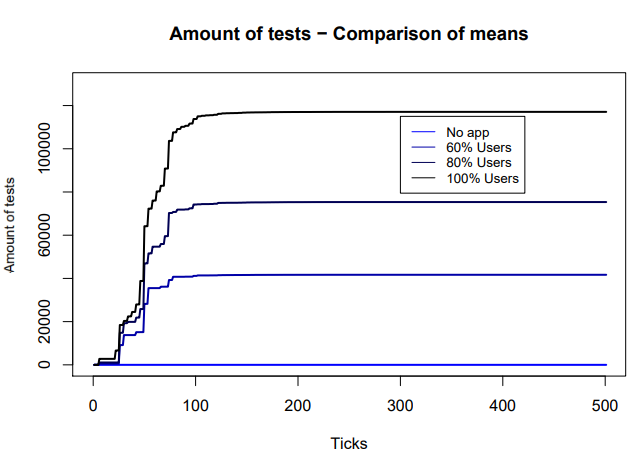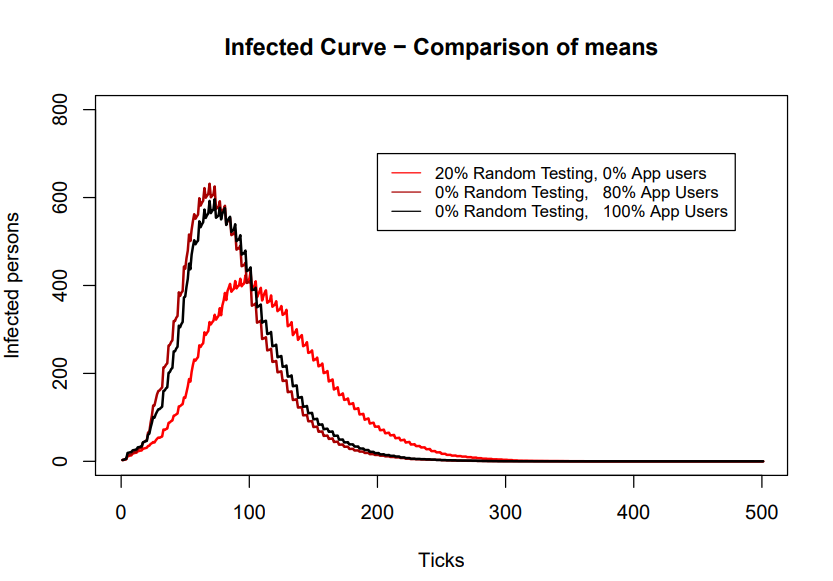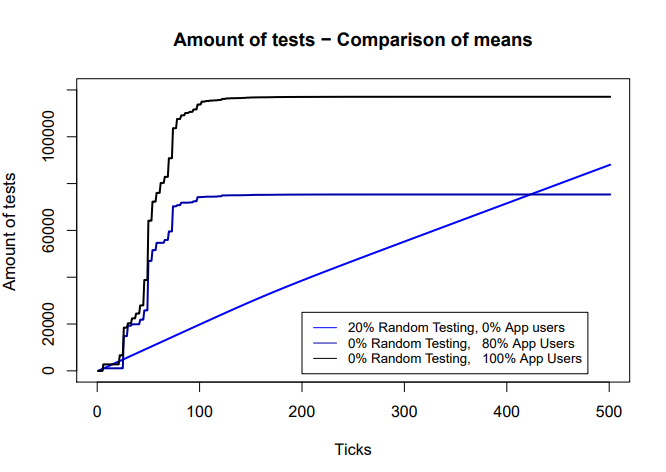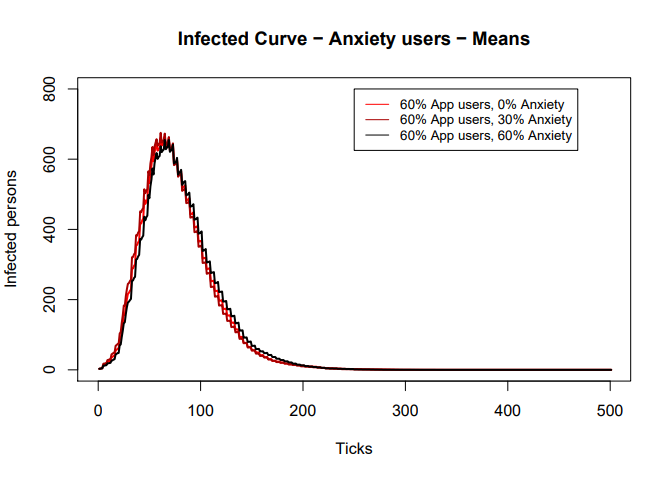PRE2019 4 Group10: Difference between revisions
TUe\20181442 (talk | contribs) No edit summary |
TUe\20181442 (talk | contribs) No edit summary |
||
| Line 1: | Line 1: | ||
=Project Robots Everywhere= | =Project Robots Everywhere - The Corona App= | ||
In these turbulent times, Corona has been affecting our daily lives. It has been such an impactful disease, that the government had to come up with a solution on how to create awareness of those who have had COVID-19 and those who do not. One of the most widely discussed option in the Netherlands would be a Corona Mobile Application (Corona App). | In these turbulent times, Corona has been affecting our daily lives. It has been such an impactful disease, that the government had to come up with a solution on how to create awareness of those who have had COVID-19 and those who do not. One of the most widely discussed option in the Netherlands would be a Corona Mobile Application (Corona App). | ||
Revision as of 23:16, 17 May 2020
Project Robots Everywhere - The Corona App
In these turbulent times, Corona has been affecting our daily lives. It has been such an impactful disease, that the government had to come up with a solution on how to create awareness of those who have had COVID-19 and those who do not. One of the most widely discussed option in the Netherlands would be a Corona Mobile Application (Corona App).
However, there is still a lot of discussion surrounding this app and its applications. The goal of the Corona App is to give an insight into the current spread of the virus, such that regulations can be implemented or improved, based on this spread. In this project, however, the focus will lie solely on the effectivity of such an app and it’s requirements for this. Effectivity will be the focus because if an app can’t be efficient enough, it would be useless to implement. This is also the reason why there will be no focus on other social questions such as privacy.
Based on literature reviews, simulations, and user-testing, these requirements will be listed and a proposal will be formed about the effectivity of such an app.
Groupmembers
Authors: Ezra Leeuwenhage, Paulien Teuwen, Yorn Thijssen, Ries van de Ven, Kim Wintraecken
Problem statement and objectives
TThe issue capturing global attention in recent months is the Covid-19 pandemic, causing great disruption throughout the world in both in terms of health care and economy. Many governments have since the outbreak opted for an approach to combat the virus through limiting all social interactions within society (commonly referred to as a lockdown), putting a halt to its spread at the cost of national economy. In the long term this approach is not sustainable however, leading to the need to find ways to reduce restriction on social interaction in all aspects of society without losing grip of the spread of the virus. To this end, the Dutch government has suggested the nation-wide employment of an application designed to predict/ detect infection with Covid-19 of civilians, enabling them to accurately manage the virus’s impact on society without the need for a type of lockdown. The need for such an app is still being questioned, since it brings a lot of difficulties with it, regarding the violation of the Dutch privacy legislation.
However, there would be no need to check all social implications in detail, if such an app is simply not efficient enough to contribute to the curbing of the virus. Since in this scenario, it would be fruitless to implement such an app. This project will shed light on the requirements that need to be met, to make the app efficient enough to combat the Covid-19 pandemic.
The objectives of this project will be to determine through literary research what the relevant requirements are to the problem and what exactly the desired effectiveness of the application is in order to meet its requirements. Finally, the objective of practical research done thereafter will be to determine what type of implementation of the app satisfies the requirements set by the results from literary research.
Who are the users?
Users:
- Smartphone users
- Dutch citizens (who own a smartphone)
Other stakeholders:
- Government
- Public health authorities
- Hospitals
- Healthcare personnel
- Outbreak Management Team
What do they require?
Users require:
- Safety check
- Did I come in contact with anybody who is registered with the virus, or who has recovered from the virus?
- Raise own awareness of spreading possibilities
- How can I prevent the spread of the virus myself?
- Current information about situation
- News-updates
- Latest governmental conferences
- Current national measurements
- Healthcare issues and prevention methods
- How can I protect myself?
- What to do if I need to leave the house for necessity?
Stakeholders require:
- Additional data about the spread of virus
- New data can be used to make estimations or inform the country
Approach, milestones, and deliverables
Approach
Solving the problem around the corona app has a difficult set of objectives: first the group should evaluate the existing research about the corona app and the current simulations that exist regarding the efficiency of such an app. Next, different simulations must be compared an analyzed to specify a list of requirements and parameters. Based on these requirements, a new simulation will be created that solely focusses on the efficiency.
These results should confirm or deny earlier research and the goal is to determine if a corona app would be suitable to achieve the combat of the virus.
Milestones
A certain milestone is composing the requirements for the corona app. Choosing the requirements depends on the research and the type of app. The requirements must ensure the app is efficient. Another milestone would be making the simulations for testing.
Week number: Tasks
Week 1: Background study
Week 2: Requirements
Week 3: requirements and parameters
Week 4: Requirements and parameters. Comparing different existing simulations. Contacting different organizations to discuss their results
Week 5: Start making simulation. Continue research in requirements and parameters
Week 6: Continue Simulation
Week 7: Testing (survey) & Simulation testing
Week 8: Final presentation and demo (recorded video)
Deliverables:
The output of the project should be an analysis of a simulation made to map the effectiveness, as well as a proposal containing the requirements that need to be met. Furthermore, a wiki page containing all information on the process of the project and the final presentation of week 8 will be delivered.
Who is doing what?
To create a full detailed planning for the hole course is difficult, especially in situations like these where we do not know what we are capable of and things can change every week. Therefore, we have chosen to divided tasks after each meeting or every week just like in an OGO project. These assigned tasks will be published weekly on the wiki in a table. However, to keep track on the schedule, some team members will be assigned to have a leading role over a part in the project.
Furthermore, because we are doing the project like an OGO project, we also assigned roles for Chairman and Minute taker for each meeting. This will be according to the following schedule:
Meetings per week:
Monday - 09:30
Thrusday - after tutoring session
Date Chairman Minute taker
27/04 Kim Ries
30/04 Ries Yorn
04/05 Yorn Ezra
07/05 Ezra Paulien
11/05 Paulien Kim
14/05 Kim Ries
18/05 Ries Yorn
21/05 Yorn Ezra
25/05 Ezra Paulien
28/05 Paulien Kim
01/06 Kim Ries
04/06 Ries Yorn
08/06 Yorn Ezra
11/06 Ezra Paulien
15/06 Paulien Kim
18/06 Kim Ries
Weekly hours
Progress per Week
Week 1
Notes on literature
Week 2
After meeting with our tutor adjustments to the planning above were made. In summary, the project was scaled down to a concise and reachable set of goals and tasks and the emphasis for the first few weeks was shifted towards setting valuable, precise and well-founded requirements for an implementation of the corona app. Details of that particular meeting have been recorded here:
File:Notities conference call 1.pdf
- insert progress by Paulien (simulation software viability)*
Week 3
The requirements to be set were discussed in meeting 4 (File:Minutes 04 05 20.pdf) and these were the main results in terms of type of requirements to be investigated en quantified: - Users & habits (of dermatological application software) - Combatting virus spread
Other useful leads in advancing the project that were explored: - Viability and reliability of employment of simulation software (by TU Delft) for testing effectiveness of corona app
More detailed information on the requirements can be found in the minutes and the research below.
File:Bestrijding van verspreiding.pdf
Week 4
File:Hw kim simulation simulation delft.pdf Analysis simulation model Delft ASSOCC
The ASSOCC model (Agent-based Social Simulation for the COVID-19 Crisis), is a model that has specifically been designed and implemented by European researchers from Umeå University, TU Delft, Malmö University, Utrecht University, Caen University and Stockholm University to address the societal challenges of the COVID-19 pandemic.
What exactly is it? [1]
This model uses “corona in Simcity” approach to study individual and social reactions to the containment policies. It is a tool for decision makers to explore different scenarios and their effects. It is not a model to generate predictions. It simulates the behavior of a synthetic population given a set of policies (for example when in a lock-down or voluntary isolation). It enables to study the effects on both the spread of the contagion and on how people can be expected to react to the policies (e.g. potential violations or workarounds).
What answers does it provide? [1]
It models both the possible effects on the spread of the coronavirus and the socio-economic effects of the policies, providing possible answers to:
• How might policies based on achieving drastic behavioral change go wrong?
• How might one work with existing social norms and habits to effectively limit virus spread (what will work with populations and what will not?)
• How might we reintroduce people who have recovered from the disease back into society to help others and revive the economy without this leading to social division and a general breakdown of social distancing?
• What are the possible dangers of social polarization between vulnerable older people and the young who want to get together, how might we keep younger people “on board”, how might we stop them losing contact with other generations?
• For particular groups within societies, at particular times of year or day are there safe gathering activities with very low risk of contagion? Are there practices that are particularly dangerous.
• What new social practices might we develop that allow life in a world susceptible to waves of new infection (e.g. red and blue teams in hospital so there is no overlap)?
• Timing and consequences of lifting the restrictions
How does it work? [1]
ASSOCC is made in NetLogo. It is based on a set of artificial individuals, each with given needs, demographic characters, and attitude towards regulations and risks. All the agents decide each time what they should be doing and because of this, many different possible effect of policies can be analyzed.
This figure is a screenshot of the parameter setting in the NetLogo model. (ASSOCC, 2020)
More information about what each parameter means can be found in the pdf: “Hw Kim simulation delft’.
The framework is based on the fact that individuals have to balance their needs over many contexts.
The following image shows how people manage this balancing act in their daily life:
More information about this image can be found in the pdf: 'Hw Kim simulation delft’.
Agents selecting an action: [1]
1. an agent creates a list of all possible places (gathering-points) it can go with different motivations = an action this list is based on their current age, time of day, day in week, parameters set in the model
2. for all these actions, the global expected effect on the needs is calculated (summing over the expected effects x the desire for each main need)
3. the action that satisfied the highest number of needs is selected to be acted upon
after all agents have moved to the location where they want to execute their action, the actions get executed, and the needs get updated
Track and trace apps [2]
ASSOCC has looked at the policy of implementing the ‘corona app’ into society. In their scenario, they assumed a perfect app aligned with all functional, legal and ethical requirements. They studied the effectiveness of such an app by performing 3 experiments:
1. The effect of the app depending on different percentages of the population using the app
2. Comparing the effect of using the app with that of random testing a percentage of the population
3. Effect of the app depending on the characteristics of the users (percentage of risk-avoiding agents that use that app)
The following conditions were used:
• Percentage of app users = (0%, 60%, 80% or 100%)
• Percentage of app users = 0.0 and percentage of population tested randomly daily = (0% or 20%)
• Percentage of app users = 60% and percentage of risk avoidance app users = (0%, 30% or 60%)
Results [2]
Experiment 1: Differing amounts of population using the app
According to ASSOCC, using the app results in a lower infection peak. However, the differences are not significant in a test using 15 randomised runs for each setting, as depicted in curve1.png comparing the settings for no app users, 60% app users, 80% app users and 100% app users, with a population of 1000 agents.
However, as depicted in curve2.png, increasing the number of users results in a sharp increase of testing given that all those that are alerted of being in contact with an infected agent will need to be tested (or required to quarantine themselves).
These results left ASSOCC with the question how does the usage of the app compare with a similar amount of random testing. This gave the basis for experiment 2.
Experiment 2: comparing tests performed through app with random testing
According to ASSOCC, random testing raises infection awareness even when the tested agent had no reason to suspect infection. The differences on number of infected agents under different conditions is shown if curve3.png
Experiment 3: effect of the type of app users.
Next, ASSOCC hypothesized that the people who are most likely to use the app are probably those that are more risk averse. However, in initial tests, they were not able to see a significant difference under this condition.
Conclusion: [2]
The effectiveness of tracking and tracing apps on lowering the number of infected agents is limited and lower than that of random testing. The use of the app results in a sharp increase on the number of agents that need to be tested, which may be above the capacity available in the system.
ASSOCC therefore concludes from this data that the app (with around 60% use) makes no significant contribution to a virus-free Netherlands.
Results show that by themselves these apps have none or minimal effect on the spread of the virus. Besides all legal, constitutional and ethical issues, their use may lead to a false feeling of security which ultimately can contribute to a second wave of the contagion [3].
Other studies, based on large scale mathematical models of epidemics show the opposite effect. I.e. according to those studies, track and trace apps do have a positive effect on the containment of the virus [3].
It is important to compare these types of studies and see why they lead to different results.
The major difference between the ASSOCC model and those used by many epidemiologists is that ASSOCC has a simulation based on human behavior which is used together with the epidemiological model [3].
The important difference between ASSOCC model and other models, lies in a number of specific properties of the corona virus:
1. The time between becoming infected and possibly showing symptoms is quite long. In an epidemiological model, this is translated by giving a parameter a different value. However, when looking at how many interactions people have, and with which other people, probabilistic model in a mathematical model can be used that divides the interactions uniformly or normally over all possibilities. That differs somewhat from reality if the interval in which this happens is short, but not so much that it disturbs the results a lot. However, if that interval becomes longer, the mathematical model is no longer correct. This is often seen in macroeconomic models: they do reasonably well in normal situations, but in crisis situations people do not behave according to expectations and the deviations are too great to make those models even of value.
2. Another issue is the skewed age distribution of the corona virus infection: relatively many young people are asymptomatic. So they are infected without knowing it and spread (with lower chance, but still) the virus. Because they are not being tested, this distribution continues. Young people also meet more other young people on average, so the contagion can go on for quite some time before being noticed. From the perspective of the track and trace apps, this means that people have already fallen from the contact list that is about a week long. In this way, there are a lot of points along which the virus still spreads despite the use of the app.
3. Demographics and living arrangements are also a determining factor. For example people lives who live in Italy look a little different than in the Netherlands. So the results are slightly different, but the conclusion remains. In the Italian case, the positive effect of testing randomly 20% of the population is even greater than in the Netherlands.
The issues above are not easy to capture in macro level models, as those used in epidemiology. ASSOCC considers the difference between people’s ages, backgrounds, living situation and behavioral motives. Many scientific studies point out that the lack of a human behavior model in the epidemic models is a problem. ASSOCC is one of the few in the world that combines the human models with the epidemic models. It would be nice if a lot more research was done, because then this type of models would improve greatly and there would be more comparative studies.
[1]ASSOCC. (2020, April 20). The simulation. Retrieved from https://simassocc.org/assocc-agent-based-social-simulation-of-the-coronavirus-crisis/the-simulation/
[2] ASSOCC. (2020b, April 21). Scenario: effect of track&trace apps. Retrieved from https://simassocc.org/scenario-effect-of-tracktrace-apps/
[3] Dignum, F. (2020, April 19). Mathematics vs. social models: how to understand the sociology of corona virus spread. Retrieved from https://simassocc.org/assocc-agent-based-social-simulation-of-the-coronavirus-crisis/news-and-publications/






